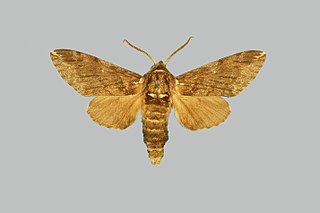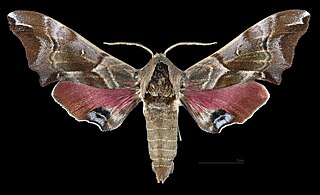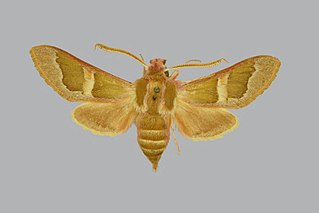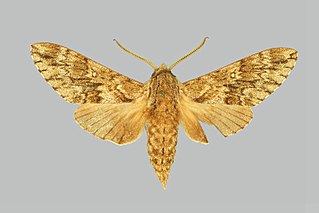
The willowherb hawkmoth is a moth in the family Sphingidae. The species was first described by Peter Simon Pallas in 1772.

Hippotion rosetta, or Swinhoe's striated hawkmoth, is a sphingid moth of the family Sphingidae. The species was first described by Charles Swinhoe in 1892.

Akbesia is a monotypic moth genus in the family Sphingidae erected by Walter Rothschild and Karl Jordan in 1903. Its only species, Akbesia davidi, the pistacia hawkmoth, was first described by Charles Oberthür in 1884. It is known from southern Turkey, northern Syria, northern Israel, western Jordan, south-eastern Turkey, north-eastern Iraq, south-eastern Georgia, northern Iran, eastern Afghanistan and Iranian Beluchistan. It may also occur across Azerbaijan, the Alborz Mountains of northern Iran, the Zagros Mountains of western and southern Iran, and northern Afghanistan. It often occurs in large numbers at certain sites in rocky, hilly areas supporting scattered trees and shrubs of Quercus, Olea, Ceratonia and Pistacia.

Hyles nicaea, the Mediterranean hawk-moth, is a moth of the family Sphingidae. The species was first described by Leonardo de Prunner in 1798.

Microsphinx is a genus of moths in the family Sphingidae, consisting of one species, Microsphinx pumilum, which is known from South Africa.

Sphingonaepiopsis is a genus of moths in the family Sphingidae.

Dolbina elegans, the ash hawkmoth, is a moth of the family Sphingidae. The species was first described by Andreas Bang-Haas in 1912. It is found from Ukraine, Moldavia, through eastern Romania and eastern and southern Bulgaria, northern Greece, western and southern Turkey to northern Syria, western Jordan, Israel, northern Iraq and northern Iran.

Smerinthus caecus, the northern eyed hawkmoth, is a moth of the family Sphingidae. The species was first described by Édouard Ménétries in 1857.

Smerinthus kindermannii, the southern eyed hawkmoth, is a species of moth of the family Sphingidae. It is found throughout the central Palaearctic Region, from Turkey, Cyprus and Lebanon, east through Iraq, Iran, Afghanistan and northern Pakistan to Kashmir. From there, north and north-east through Turkmenistan, Uzbekistan, Tajikistan, Kyrgyzstan and Kazakhstan, to north-western China. It has also been reported from Israel and Kuwait.

Sphingonaepiopsis gorgoniades, the Gorgon hawkmoth, is a moth of the family Sphingidae. The species was first described by Jacob Hübner in 1819. It is found from Croatia, Albania, Macedonia, central and southern Greece, eastern Bulgaria and Romania across southern Ukraine and the Crimea, southern Russia as far north as Kazan, the southern Urals and eastern Kazakhstan to Kyrgyzstan and Afghanistan. It has also been recorded from central and southern Turkey, Lebanon, Israel and western Jordan eastward across northern Iraq, the Caucasus, northern Iran to southern Turkmenistan.

Sphingonaepiopsis nana, the savanna hawkmoth, is a moth of the family Sphingidae. The species was first described by Francis Walker in 1856. It is found from the Kerman Province, Hormozgan Province and Baluchistan in southern Iran and western Saudi Arabia to the southern Arabian Peninsula and eastern Africa to Natal, west to the Gambia.

Hyles zygophylli, the bean-caper hawkmoth, is a moth of the family Sphingidae. The species was first described by Ferdinand Ochsenheimer in 1808. It is found in western and eastern Turkey, Armenia, eastern Transcaucasia, Daghestan, northern Syria, northern Iran, Turkmenistan, Kazakhstan, Uzbekistan, Kyrgyzstan, Tajikistan and northern Afghanistan. It is also found from western, northern and central Xinjiang province east to Shaanxi province and north to Mongolia. There is one record of a vagrant from Croatia.

Sphingonaepiopsis pumilio, the tiny hawkmoth, is a species of moth of the family Sphingidae. It is found from Uttar Pradesh in India, east through Nepal, Bangladesh and Myanmar to China, south to Peninsular Malaysia through Vietnam and Thailand.

Hyles siehei is a moth of the family Sphingidae. It is known from southern and eastern Turkey, Armenia, northern Syria, northern Iraq and northern Iran. Then probably south along the Zagros Mountains of Iran to the Kerman Province. It is also known from lowland southern Kazakhstan, from the shores of the Caspian Sea across to the Chinese border, southern Uzbekistan and northern Turkmenistan.

Clarina kotschyi, the grapevine hawkmoth, is a moth of the family Sphingidae. The species was first described by Vincenz Kollar in 1849. It is found from the Iranian plateau and Mesopotamia to eastern and central Turkey.

Rethera brandti, the lesser madder hawkmoth, is a moth of the family Sphingidae. The species was first described by Otto Bang-Haas in 1937. It is found from south-eastern Turkey and north-eastern Iraq to southern Iran along the Zagros Mountains and then into western Pakistan. It is also present in the Alborz and Kopet Dag Mountains of northern Iran. The habitat of ssp. brandti consists of sparsely vegetated slopes up to 2,000 meters, while the habitat of ssp. euteles consists of hilly steppe and desert-edge vegetation between 1,500 and 2,500 meters altitude.

Marumba sperchius is a species of moth of the family Sphingidae first described by Édouard Ménétries in 1857.

Dolbina grisea, the mountain hawkmoth, is a moth of the family Sphingidae. The species was first described by George Hampson in 1893. It is known from northern Pakistan, Kashmir, eastern Afghanistan, Tajikistan and the western Gissar Mountains of southern Uzbekistan. The habitat consists of light, temperate montane forest, including juniper woodland.
Sphingonaepiopsis gurkoi, the Gurkoi hawkmoth, is a moth of the family Sphingidae. The species was first described by Tomáš Melichar and Michal Řezáč in 2013. It is found in Tajikistan where it has been recorded at elevations above 3,500 meters in mountain steppe areas. It is possibly also found in Mongolia.
Sphingonaepiopsis asiatica, the Kopet hawkmoth, is a moth of the family Sphingidae. The species was first described by Tomáš Melichar and Michal Řezáč in 2013. It is found in the Kopet-Dagh Mountains, along the border of northern Iran and southern Turkmenistan.

















